If you’re leading learning and development (L&D) in a large organization, you’re not just looking for another list of training methods. You’re managing multiple departments, regulatory needs, role-based learning paths and a tech stack that wasn’t built to keep up.
This guide is built for that reality.
You’ll learn how enterprise teams design and implement scalable training and development programs that actually move the needle—on performance, retention and operational efficiency.
We’ll break down the frameworks, tools and real examples that show how it works across compliance, leadership, and cross-functional development.
Quick overview: What you’ll learn
- The difference between training and development and why most orgs get it wrong
- How to set up programs that scale across roles, regions and compliance requirements
- 6 metrics that matter when proving ROI to leadership
- Real-world examples from Dematic, Vision Australia and Colliers
- Tools and systems that automate L&D without losing control
What Is Employee Training and Development?
Employee training and development is the strategic process of enhancing employees’ skills, knowledge and capabilities to improve both individual performance and organizational outcomes. While often used together, training and development serve distinct but complementary purposes in building a capable workforce.
Employee training focuses on equipping people with specific skills needed for their current roles. It’s typically short-term and task-oriented, designed to close immediate performance gaps or ensure compliance with standards. Think onboarding new hires, teaching software systems or meeting regulatory requirements.
Employee development takes a broader, long-term approach to prepare employees for future responsibilities and career growth. This includes leadership programs, cross-functional skill building and strategic thinking development that extends beyond current job requirements.
The most effective organizations blend both approaches into comprehensive programs. Take Dematic, an automation technology company that needed to rapidly develop engineers across global operations. Rather than treating training and development as separate initiatives, they created an integrated competency-based program that both certified engineers in essential technical skills and prepared them for advanced project responsibilities.
Modern employee training and development programs serve multiple organizational needs simultaneously. They bridge skills gaps, boost engagement, ensure compliance and create internal talent pipelines. When done right, these programs become strategic assets that drive business results while demonstrating genuine investment in people’s professional growth.
Key Areas of Employee Training and Development
Building effective employee training and development requires understanding how people actually learn and grow in the workplace, then designing programs that work with those realities.
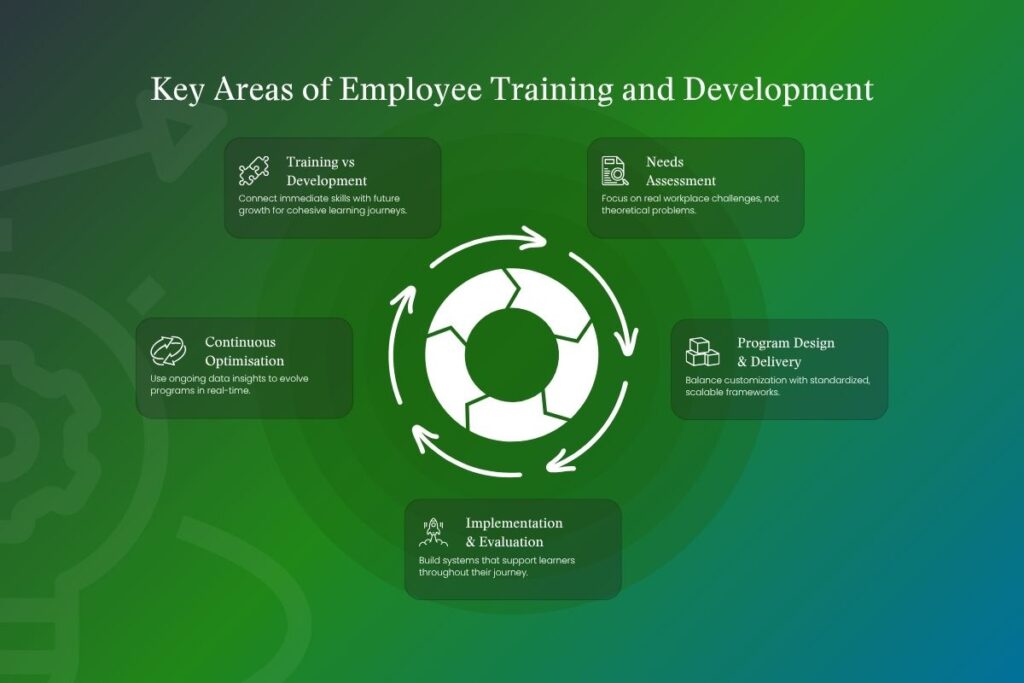
Employee Training vs Employee Development
Most organizations treat training and development like separate buckets when they’re really part of the same conversation. Training handles immediate skill needs for current roles. Development focuses on preparing people for future opportunities and responsibilities.
The most effective programs connect these two elements into a cohesive growth journey. According to eLearning Industry research, 70% of employees’ skills are learned on the job while only 10% come from formal training. This shows us that the best learning happens when embedded into actual work, not separated from it.
Needs Assessment
Many needs assessments focus on what organizations think people should learn rather than what they actually need to succeed. Only 29% of employees are satisfied with current L&D opportunities for career progression. This satisfaction gap often stems from misaligned priorities—solving theoretical problems instead of real workplace challenges that employees face daily.
Program Design and Delivery
One-size-fits-all training no longer works in today’s diverse workplace. Harvard Business Publishing Corporate Learning demonstrates smart program design by creating highly customized leadership development programs while using standardized, reusable templates. Each corporate client receives something that feels tailored to their needs while maintaining consistency and efficiency behind the scenes. Effective design balances flexibility with structure.
Implementation and Evaluation
Launch day marks the beginning, not the end, of effective training programs. Colliers Project Leaders transformed their approach by moving from managing 350 scattered courses to building competency-based learning paths with automated support systems. This systematic approach resulted in more than 4,000 course enrollments completed within the first year. Success came from better systems that actually supported people through their learning journey.
Continuous Optimization
Programs that don’t evolve become expensive museum pieces. With 63% of organizations relying on annual performance reviews to measure training impact, most feedback loops are too slow to drive meaningful improvements. The most effective programs treat data as ongoing insight rather than a final report card.
Key Benefits of Effective Employee Training and Development
Employee training and development programs deliver measurable returns when designed strategically, but the real value lies in how these benefits interconnect to create organizational momentum.
| Benefit | Supporting Stat or Example | Business Impact |
| Higher retention | 94% of employees would stay longer at companies that invest in career development | Builds internal pipelines and reduces costly attrition |
| Faster productivity | Dematic reduced onboarding time from 12 months to 8 weeks using competency-based certification | Engineers reach billable readiness faster, reducing ramp time |
| Scalable performance systems | Colliers completed 4,000+ course enrollments in one year using structured learning paths and automated support | Standardized training increases system-wide productivity |
| Greater accessibility and compliance | Vision Australia achieved 80% completion on safety training by prioritizing accessible design | Inclusion leads to higher engagement and real-time tracking for managers |
| Operational alignment | Programs designed with daily workflows in mind outperform generic training | Training becomes part of business infrastructure, not an add-on |
These benefits compound when training programs solve real workflow problems while building compliance capabilities. The organizations seeing the highest returns treat learning as operational infrastructure that supports daily work.
Ready to move from check-the-box training to competency-based programs that drive retention and performance?
See how Brightspace supports role-based learning, regional scale, and real-time insights—without adding admin overhead.
6 Roadblocks to Overcome When Implementing Your Training and Development Programs
Most training programs fail to deliver lasting organizational change due to predictable systemic barriers.
- Limited admin scope.
- L&D teams manage complex learning ecosystems with constrained resources. Manual administration consumes time that should focus on strategic program design and content quality.
- Complex organizational needs.
- Enterprise learning spans different business units, compliance requirements and regions. Without unified infrastructure, tracking progress and ensuring consistency becomes nearly impossible.
- Shifting compliance requirements.
- Regulatory changes demand immediate workforce education. Financial services face acute pressure requiring rapid content deployment while maintaining quality and completion tracking.
- Lack of engagement.
- Only 29% of employees are satisfied with current L&D opportunities. Programs disconnected from daily work realities generate performative rather than genuine engagement.
- Proving value.
- Annual performance reviews are too slow to guide improvements or justify budgets. Without real-time insights into learning application, L&D remains vulnerable during budget discussions.
- Enterprise-scale coordination complexity.
- Managing programs across multiple departments, regions and compliance requirements simultaneously creates exponential complexity. Enterprise scale requires systematic approaches that maintain consistency while allowing customization.
For more on this, read out guide on how an employee training tracker can streamline reporting, reduce manual work, and improve visibility into learner progress. Explore the path from basic spreadsheets to automated dashboards.
How to Design Employee Training Programs That Scale Across Teams and Regions
Effective training programs require more than good content. They need systematic approaches that address the operational realities of enterprise learning while delivering measurable business impact.
The organizations achieving the strongest results follow specific implementation patterns that solve common coordination challenges while maintaining program quality at scale.
1. Define Learning Outcomes that Tie Directly to Business KPIs
Most training programs fail because they optimize for completion rates instead of competency development. The difference lies in how you define and track what success actually looks like.
Instead of measuring whether someone finished a module, track whether they can demonstrate specific knowledge, skills and abilities. Enterprise platforms like Brightspace use Competencies tools to track knowledge, skills and abilities across courses.
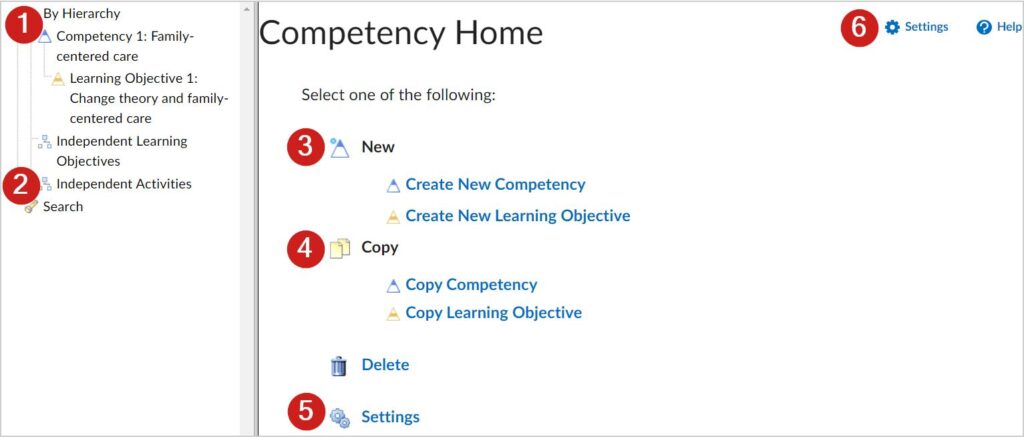
Competencies act as an inventory of organizational capabilities, not just individual grades. By mapping roles to competencies, you can clearly define what success looks like and link training to business KPIs.
During content creation, associate every assignment, discussion, SCORM package or media file with specific learning outcomes. In Brightspace, instructors can align any content item to standards by selecting the item and clicking Standards to associate relevant outcomes. This ensures each module ladders back to clear learning objectives rather than existing as standalone content that feels disconnected from actual job requirements.
2. Choose an LMS that Supports Diverse Training Formats and Central Control
Enterprise learning demands flexibility without sacrificing control. You need systems that handle everything from micro-learning videos to complex simulations while maintaining consistent tracking and quality standards.Rather than juggling external video platforms, use integrated media libraries that provide processing, storage and streaming for all audio-video content. Enterprise LMS platforms like Brightspace offer Media Library features that let admins create, view, edit and manage media centrally, with permission controls to ensure only authorised roles can access the library. This allows you to deliver micro-learning videos, recorded workshops and podcasts alongside traditional modules without switching between systems.
Many organizations have significant investments in interactive simulations or vendor-provided e-learning packages. Effective LMS platforms let you import and manage these directly alongside other content types. In Brightspace, instructors can import and manage SCORM or xAPI packages directly in the Content tool, replace packages, edit properties, and set review options. This maintains consistent tracking and learner experience regardless of the original content format, preventing scenarios where valuable training content becomes unusable due to platform limitations.
3. Automate Manual Admin Tasks to Improve Reach and Consistency
Manual administration kills program scalability. The organizations seeing the highest adoption rates build automation into their learning workflows from day one.
Set up automated systems that scan courses for specific criteria—learners with grades below thresholds, people who haven’t logged in for set periods, or those who view specific topics—and automatically trigger customized email reminders or support actions.
Tools like Brightspace’s Intelligent Agents scan your course for specific criteria and automatically send customised email nudges based on learner behavior. This automation ensures at-risk learners receive timely intervention without your team micromanaging every interaction.
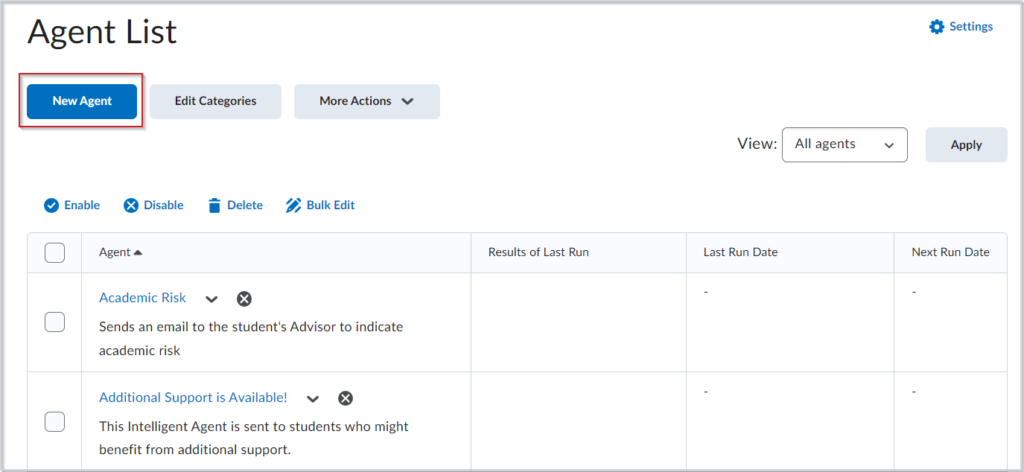
Hide or show content based on prerequisites like completing earlier topics, achieving quiz scores or participating in discussions. Multiple conditions can be combined and all must be satisfied before content becomes visible.
Brightspace Release Conditions allow you to set multiple conditions that learners must meet before accessing content, automating learning pathways without administrative oversight. This eliminates administrative policing while ensuring learners progress through foundational concepts before advancing to complex material.
4. Personalize Learning by Role, Region, and Team Without Losing Structure
One-size-fits-all training generates one-size-fits-all results. Enterprise-scale learning requires systematic approaches to customization that maintain efficiency while delivering relevant experiences.
Use group structures to deliver the same course framework while tailoring assignments, discussions, or projects to different regions or job functions. Platforms like Brightspace allow you to create group categories within a course to restrict enrolment to specific cohorts and provide separate discussion forums, assignments and lockers.
This approach allows you to maintain consistent learning objectives while adapting application to local contexts—for example, a leadership development program might use identical core modules but different case studies for engineering managers versus sales directors.
Let employees search for courses and self-enroll based on role-based access rules. By controlling which roles or regions can access certain content, you create flexible learning pathways while relieving administrators from manually enrolling every participant.
Brightspace’s Discover tool allows learners to search active courses and self-enroll, while admins can set approval rules and apply enrollment restrictions. This approach scales particularly well for skills-based training where employees can identify their own development needs within approved frameworks.
5. Build Continuous Feedback Loops into Every Learning Touchpoint
Effective programs treat feedback as ongoing insight, not final evaluation. The key is building assessment into workflows that support continuous improvement rather than just measurement.
Build analytic or holistic rubrics that attach to assignments, quizzes and discussions. This creates frameworks for consistent feedback across different evaluators and courses while making assessment criteria transparent to learners.
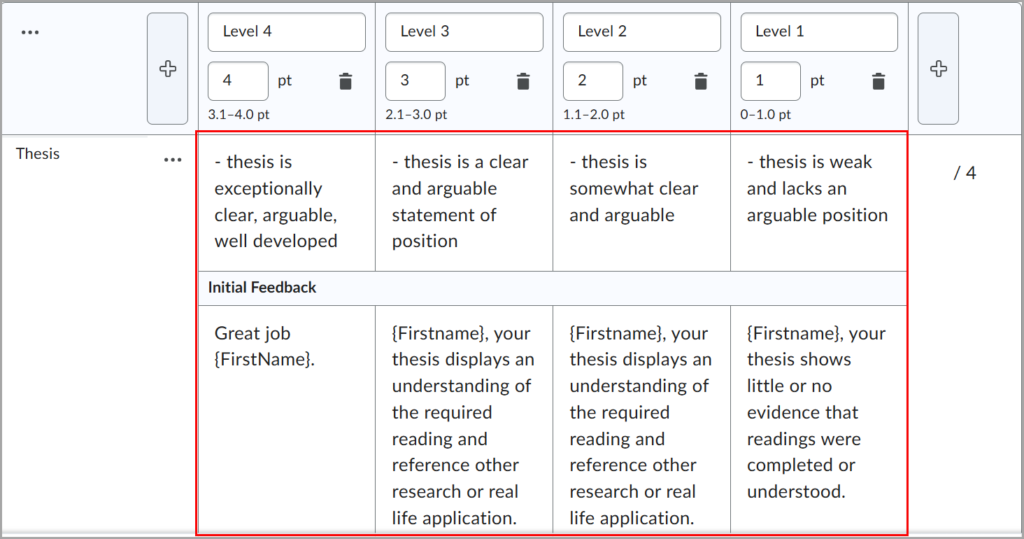
In Brightspace, the Rubrics tool lets instructors build analytic or holistic rubrics and attach them to assignments, quizzes and discussions, providing a framework for consistent, timely and meaningful feedback. Standardized rubrics become especially valuable in enterprise environments where multiple instructors or managers evaluate similar competencies across different departments.
Use built-in survey statistics to track participation and review anonymous feedback without exporting data to separate systems. This integration makes it easier to gather learner input and iterate on program design based on actual usage patterns. Brightspace’s Surveys tool provides statistics and reports that let instructors see participation numbers and anonymous response data, making it easy to gather learner feedback without switching between multiple systems.
6. Use Data Dashboards to Optimize Learning and Prove ROI
Most L&D measurement focuses on activity rather than outcomes. Effective programs track metrics that reveal both individual progress and organizational capability development.
Use dashboards that display individual performance patterns and risk indicators, showing how each learner’s progress compares to course expectations and peer performance. This enables intervention with under-performing learners while identifying high-performers for stretch assignments. Brightspace’s Learner Engagement Dashboard aggregates course data to give instructors personalised insight, displaying patterns and indicators about individual students. By viewing interactive visualisations and risk indicators, L&D teams can intervene with under-performing learners and identify high-performers for stretch assignments.

Track which modules engage learners and which may need improvement through detailed usage analytics. Reports showing learner visit patterns and time spent help identify content that resonates versus sections that create bottlenecks.
Brightspace course content statistics display the number of learners who visited each content item and the average time spent, helping you identify which modules engage learners and which may need improvement. This data-driven approach helps optimize both individual learning journeys and overall program effectiveness.
7. Create Industry-aligned Learning Paths (e.g. Financial Services, Healthcare)
Generic training programs miss the nuanced requirements that drive real business impact. Effective enterprise learning addresses the specific competency combinations that matter in your industry context.
For example, in financial services, effective programs integrate compliance training, sales skill development, and leadership capabilities simultaneously. Rather than treating these as separate tracks, design pathways that address how regulatory knowledge, client relationship skills, and team management intersect in daily work.
You can build industry-aligned programs as curated collections of courses, then surface them for targeted cohorts. Brightspace Course Catalog, a tailored LMS for financial services, allows admins to add courses or multi-course programmes, optionally set prices and manage waitlists, letting learners enrol in individual courses or complete structured programs.
By leveraging adaptive learning features, you can create paths that adjust to each learner’s knowledge gaps—ideal for cross-functional skill mapping and personalised progression. Brightspace LeaP wizard automatically aligns content to learning objectives and recommends content to learners based on their learning path.
Map competencies across different business functions to identify where skills overlap and where specialized knowledge becomes critical. This approach helps create learning pathways that support both role-specific expertise and cross-functional collaboration, with clear advancement paths that show how current role competencies build toward future responsibilities.
8. Ensure Consistency Across Regions with Import/Export and Bulk-edit Features
Global organizations need learning systems that maintain quality standards while adapting to local contexts and regulations.
Use import/export capabilities to replicate well-designed course structures across regions while allowing customization of specific content elements. This ensures every region benefits from your best program designs while accommodating local requirements. Brightspace allows administrators to import, export or copy course components such as assignments, discussions and quizzes, creating duplicates when component names already exist.
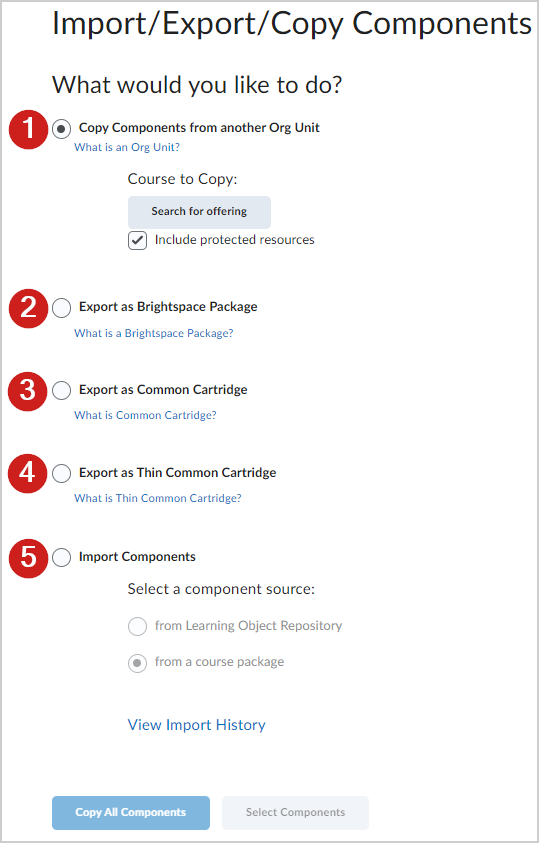
This approach lets you copy a well-designed course shell to ensure every region or department uses the same baseline content, saving time and enforcing quality standards.
When deploying programs across time zones or different cohort schedules, use bulk editing tools to adjust due dates and availability windows without manually updating each component. Brightspace’s Manage Dates tool allows instructors to bulk edit due dates and availability dates for course content and intelligent agents, letting you select items to update and click Bulk Edit Dates. This systematic approach becomes essential when managing compliance training that must meet different regulatory timelines across multiple jurisdictions while maintaining unified quality standards.
Building Training and Development Programs that Drive Business Results
Enterprise training programs succeed when they solve coordination challenges while creating genuine advancement pathways. The organizations seeing the strongest returns treat learning as operational infrastructure that integrates with daily workflows rather than standalone events.
The difference lies in systematic implementation. Effective programs automate administrative tasks, personalize pathways across roles and regions and measure competency development rather than just completion rates. When learning becomes embedded into how work gets done, it transforms from cost center to competitive advantage.
Your learning infrastructure should support both immediate operational needs and long-term talent development simultaneously. The question becomes whether your current systems can scale sophisticated programs while maintaining the quality standards your enterprise demands.
AI-powered, personalized training and development at enterprise scale
FAQs About Employee Training and Development
What Metrics Should We Track to Prove Training ROI?
Track KPIs that go beyond course completions:
- Role-specific competency improvements
- Time to productivity (e.g. onboarding reduction from 12 months to 8 weeks)
- Compliance pass rates and re-training intervals
- Retention rates by training participation
Use tools like Brightspace’s Learner Engagement Dashboard to visualize learner performance and flag intervention points.
Read our guide on how to calculate training ROI using D2L’s IMPACT Framework. Move beyond completion rates to measure real business impact with confidence scoring.
How Can We Automate Enterprise Training Without Losing Control?
Use LMS tools like intelligent agents, release conditions and bulk content management to automate workflows while enforcing standards.
Example: Automatically nudge learners who haven’t completed compliance modules, or restrict access to advanced content until prerequisites are met.
What’s the Best Way to Personalize Learning Paths by Role or Region?
Use group-based course delivery and role-based discovery tools.
Brightspace’s group categories and Discover tool let you:
- Serve the same course framework to different teams with tailored content
- Let employees self-enroll in relevant content based on their job title or function
- Control access while enabling autonomy
How Do We Scale Training Across Global Teams With Different Regulations?
Use course import/export and date management features to:
- Clone high-performing course shells across teams
- Adjust timelines and due dates in bulk (e.g. by region)
- Maintain consistency in training outcomes while adapting to local compliance needs
